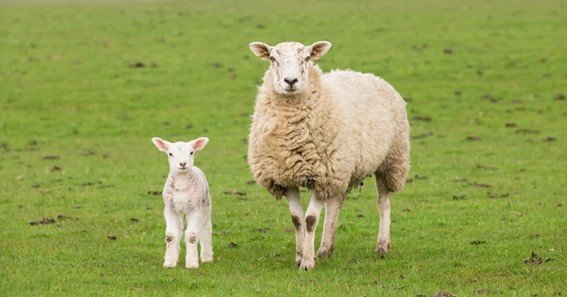What is the Difference between sheep and lamb? People commonly use “sheep” and “lamb” interchangeably, which is confusing. However, recognizing the distinction is crucial for farmers, cooks, and animal lovers.
According to the dictionary, lambs are juvenile animals, whereas sheep are adults. These variances affect their agricultural tasks, care, and usage in other sectors.
What Is The Difference Between Sheep And Lamb?
Sheep are adults of lamb whereas lamb is a young sheep. Lambs have soft flesh and are lively, but they become sick and wounded quickly and need special care. Sheep provide wool, milk, and meat.
Most are over a year old, and each breed has its unique traits. Shepherds produce wool and meat, but lambs are crucial to farming because they have varied feeding patterns and require different management.
Use Of Sheep And Lamb Based On Their Differences
Farmers and cooks must distinguish lambs from sheep. Recognizing these disparities in age, market worth, and healthcare demands helps manage and use these animals’ resources. Let’s delve into the crucial points to consider about lamb and sheep.
Age Differences
Age is the primary distinction between sheep and kids. Lambs are young sheep under a year old. This age gap affects their size, behaviour, and care.
Lambs are usually smaller, more energetic, and sicker. However, sheep are older, more prominent, and more robust and have distinct health and dietary demands. Age variations are considerable for proper animal care and control.
Dimensions And Weight
Sheep weigh more than lambs. Adult sheep weigh 60–125 kg, depending on breed. However, lambs weigh 25–40 kg. Size affects market value, handling, and product kind. Due to their size, older sheep provide excellent fleece, while newborns make delicate meat.
Goodness Of Wool
People harvest sheep’s wool to produce garments. Due to breed, fine Merino wool and bulkier Cheviot wool are distinct. Lambs’ wool is softer and finer due to less cutting.
Lambswool is smooth and used to produce high-quality garments. Knowing sheep and kid wool output and quality helps farmers and manufacturers breed and shear them better.
Meat Quality
Lamb is considered tastier than mutton, which comes from older sheep. Lamb is excellent in many dishes because of its finer texture and gentler taste.
Younger meat contains less fat and a smaller grain, which is beneficial. Due to its richer taste and coarser texture, specific classic recipes may choose mutton—selling, pricing, and preparing lamb and mutton differently due to their differences.
Different Diet
Lambs and sheep are vegetarians but have distinct diets. Lambs require a nutritious diet to increase. Mother’s milk or carefully prepared meals can provide this. Adult sheep consume predominantly grass and hay. As lambs develop from milk to solid meals, their nutritional demands fluctuate, so watch them.
However, feeding adult sheep keeps them healthy and productive to provide wool, milk, or meat. Babies and sheep must eat well to be healthy and happy.
Having Kids
When sheep reach a year, they can have babies. Lambs don’t reproduce because they’re young. You must understand this cycle to keep ewes and lambs healthy and productive. Successful breeding strategies consider animal health, genetic variation, and optimal reproductive age.
Farmers must monitor breeding to prevent the group from growing too large and dying. Lambs and adult sheep need proper reproduction to stay healthy and active.
Social Characteristics
Sheep live in flocks and have many social characteristics. Lambs are playful and gallop around fields. Their performance and how you treat them depend on group dynamics.
Babies adapt to the flock by learning to behave in different animals, from older sheep to their kind. To reduce flock stress and boost productivity, understand these social processes.
Health And Pet Care
Lambs need constant monitoring and vaccinations since they become ill more easily. However, sheep adults are more complex but require frequent examinations to avoid common diseases.
For flock health, both age groups must visit the vet periodically. Lambs need frequent health checkups and vaccinations to prevent common infections.
Adult sheep are more robust but still need preventative care to avoid illness, which can harm their well-being and work.
Cost Of Sheep And Lamb
Sheep and lambs generate various economic commodities. Lamb meat is widespread, and older sheep have wool, milk, and reproduction.
Farmers must balance these aspects to maximize profits. The demand for lamb meat can influence breeding decisions, and adult sheep’s wool production can affect wool production profitability.
Conclusion
Anyone who raises or utilizes sheep or lambs must understand their distinctions. Age, stature, diet, and wealth distinguish them.
These variations affect their breeding, agriculture, and cuisine. By understanding these distinctions, we may make better growing and eating selections, improving animal handling and health.
FAQ
What’s The Main Difference Between Lamb And Sheep?
Their primary difference is age. Lambs are under one year old, while sheep are adults. This age gap affects their size, behavior, and care.
Why Is Lamb Pricier Than Sheep?
The delicate and delectable lamb is more expensive and appreciated in many nations than mutton, which comes from older sheep. Lamb is more valued because of its finer texture and softer taste.
Can Lambs Produce Wool?
Wool is sheep-derived yet softer and finer. Lambs are cut less often than sheep because they are young. Lambswool is smooth and used to produce high-quality garments.
Lambs Consume What?
Young lambs solely eat their mother’s milk. As they age, they eat grass, hay, and specially formulated meals to grow. They must eat well to develop quickly and stay healthy.
How Do Farmers Ensure Chicks Are Healthier Than Adult Sheep?
Lambs require more checkups and vaccinations since they become ill more regularly. Adult sheep are more challenging but still need frequent vet visits to avoid common diseases and maintain the flock’s healthily. Baby and adult sheep require frequent medical treatment to keep them healthy and productive.










